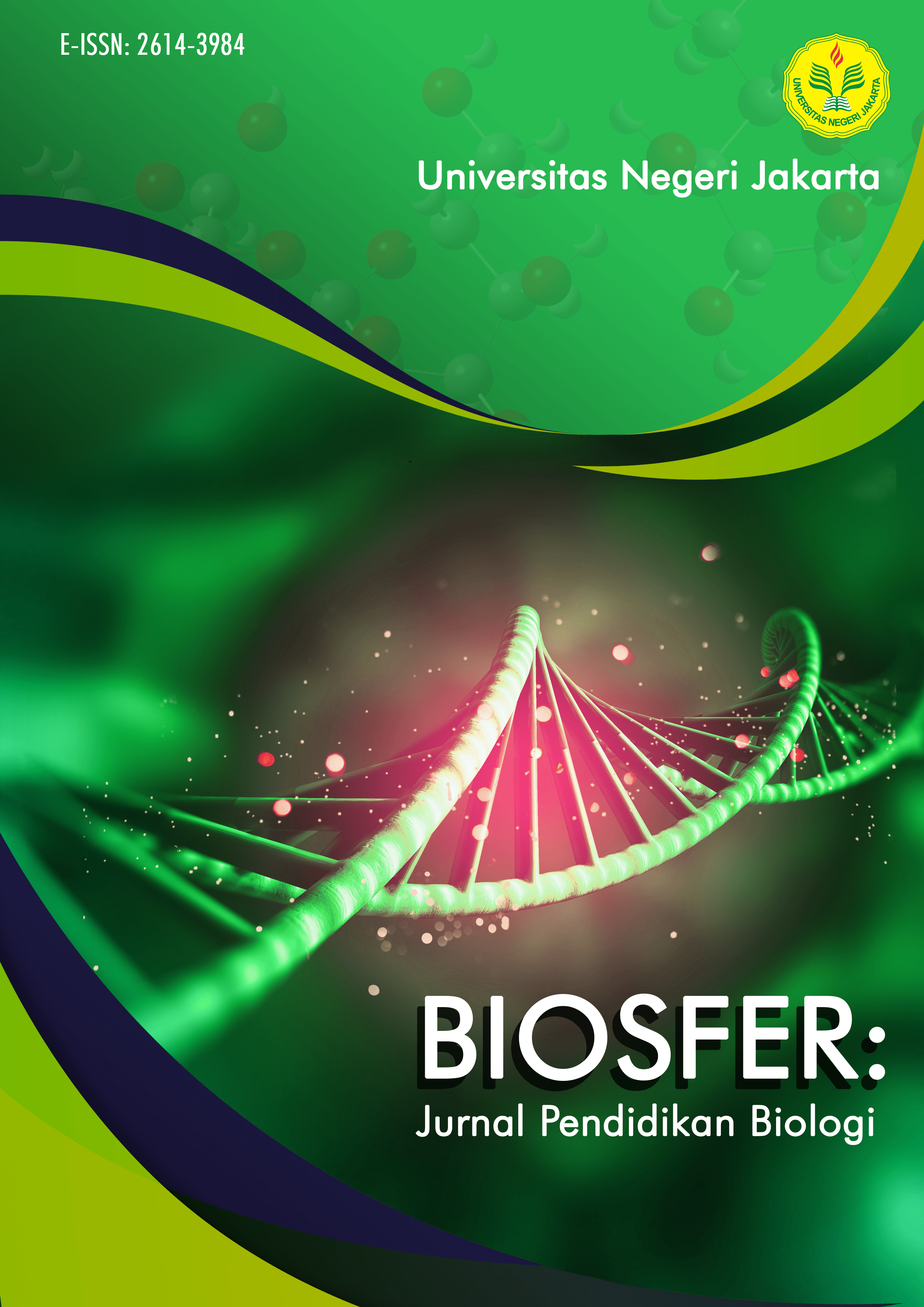Experiential learning model with mind mapping on fungi: how to improve science process skills?
DOI:
https://doi.org/10.21009/biosferjpb.v12n2.223-237Keywords:
Experiential, fungi, learning model, mind mapping, science process skillsAbstract
This research aimed to find out the effectiveness of experiential learning (EL) model with mind mapping to improve the science process skills (SPS) on fungi materials. It was quasi-experiment research by using pre-test post-test control group design. The population of the study was all of the tenth-grade students of Kalasan State 1 Senior High School amount of 127 students in the odd semester in 2018/2019 of the school year. Sample techniques were cluster random sampling. The sample consisted of 26 students (10 students male and 16 students female) as the experiment class by implementing EL model with mind mapping and 26 students (9 students male and 17 students female) as control class by using 5M (observing, asking, collecting, associating, communicating) learning model. The used instrument was ten essay questions. The data of the research were analyzed by using t-test (independent sample t-test). Based on the result of the normalized gain score, it showed that there was an improve of SPS about 0,85 in the experiment class higher than that in the control class about 0,70. Besides, it also showed a significant value (2-tailed) that was 0,000 (<0,05). It meant that there was a difference in science process skills between the experiment class and control class, so the learning process through EL learning model with mind mapping proved useful to improve the students’ science process skills.
References
Frydenberg, Mark, and Diana Andone. "Learning for 21st Century Skills." International Conference on Information Society. London: IEEE, 2011. 314-318.
Asosiasi Penyelenggara Jasa Internet Indonesia. "Survei Internet APJII 2016." APJII. 2016. https://apjii.or.id/survei2016 (accessed Januari 17, 2018).
Astra, I Made, Hadi Nasbey, and Aditiya Nugraha. "Development of an Android Application in the Form of a Simulation Lab as Learning Media for Senior High School Students." Eurasia Journal of Mathematics, Science & Technology Education 11, no. 5 (2015): 1081-1088.
Kemendiknas. Peraturan Menteri Pendidikan Nasional Nomor 02 Tahun 2008 Pasal 6 Ayat 2 dan 3 tentang Penggunaan Buku di Satuan Pendidikan. Jakarta: Departemen Pendidikan Nasional, 2008.
Rokhmah, Aulia. Penyusunan Buku Suplemen Mapel Geografi SMA Kelas XI Semester 1 Kurikulum 2013 Berbasis Android. Semarang: Universitas Negeri Semarang, 2015.
Maryam, Siti. "Strengthening the Character: Uphold Ethics in Indonesian Language Study Pass by Supplementary Books." EDUCARE: International Journal for Educational Studies, 2012: 39-50.
Muzakir. Penulisan Buku Teks yang Berkualitas. Bandung: Universitas Pendidikan Indonesia, 2013, 13-15.
I. A. D. Astuti, R. A. Sumarni, and D. L. Saraswati, “Pengembangan Media Pembelajaran Fisika Mobile Learning berbasis Android”, jpppf, vol. 3, no. 1, pp. 57 - 62, 2017.
S. Syahrowardi and A. H. Permana, “Desain Handout Multimedia Menggunakan 3D Pageflip Professional untuk Media Pembelajaran pada Sistem Android”, jpppf, vol. 2, no. 1, pp. 89 - 96, 2016.
D. Ambarwulan and D. Muliyati, “The Design of Augmented Reality Application as Learning Media Marker-Based for Android Smartphone”, jpppf, vol. 2, no. 1, pp. 73 - 80, Jun. 2016.
B. R. Simanjuntak, D. Desnita, and E. Budi, “The Development of Web-based Instructional Media for Teaching Wave Physics on Android Mobile”, jpppf, vol. 4, no. 1, pp. 1 - 10, Jun. 2018.
S. Sarinah, D. Muliyati, and I. M. Astra, “Merancang Komik Cerita Tokoh Menggunakan Aplikasi Comicker sebagai Media Pembelajaran”, jpppf, vol. 2, no. 1, pp. 103 - 110, 2016.
F. Savila, I. M. Astra, and D. Muliyati, "Pengembangan Komik Biografi Sir Isaac Newton Sebagai Media Pembelajaran Fisika Menggunakan Aplikasi Paint Tool SAI." Gravity: Jurnal Ilmiah Penelitian dan Pembelajaran Fisika, vol.4, no.2, 2018.
D. Muliyati, S. Siswoyo, D. Rahmadini, “Komik efek fotolistrik : komik sejarah efek fotolistrik dari 5 ilmuwan.” CV Green Circle Digital, 2017.
D. F. Saputri, S. Fadilah, and W. Wahyudi, “Efektivitas Penggunaan Buku Ajar Fisika Matematika Berbasis Inkuiri dalam Perkuliahan Fisika Matematika”, jpppf, vol. 2, no. 2, pp. 7 - 14, 2016.
D. Desnita, N. Fadilah, and E. Budi, “Pengembangan Buku Pengayaan Kajian Fisis Peristiwa Angin Puting Beliung untuk Siswa SMA”, jpppf, vol. 2, no. 2, pp. 97 - 104, 2016.
S. Maulana, D. Desnita, and R. Raihanati, “The Development of Knowledge Enrichment Books Concerning Ice and Snow Physical Studies for High-School Students”, jpppf, vol. 4, no. 2, pp. 83 - 90, 2018.
H. Anis and A. M. Yusuf, “Implementasi Lembar Kerja Berbasis Pertanyaan Produktif untuk Meningkatkan Kemampuan Berinkuiri Siswa SMA”, jpppf, vol. 2, no. 2, pp. 23 - 30, 2016.
D. Saepuzaman and Y. Yustiandi, “Pengembangan Alat Peraga dan Lembar Kerja Percobaan Penentuan Koefisien Restitusi untuk Meningkatkan Kemampuan Siswa Bereksperimen”, jpppf, vol. 3, no. 2, pp. 145 - 150, 2017.
Sugiyono. Metode Penelitian Kuantitatif, Kualitatif dan R & D. Bandung: Alfabeta, 2012.
Sundayana, Rostina. Statistika Penelitian Pendidikan. Bandung: Alfabeta, 2014.
Downloads
Published
How to Cite
Issue
Section
License
The Authors submitting a manuscript do so on the understanding that if accepted for publication, copyright of the article shall be assigned to Biosfer: Jurnal Pendidikan Biologi (Biosferjpb) and Departement of Biology Education, Universitas Negeri Jakarta as publisher of the journal.



